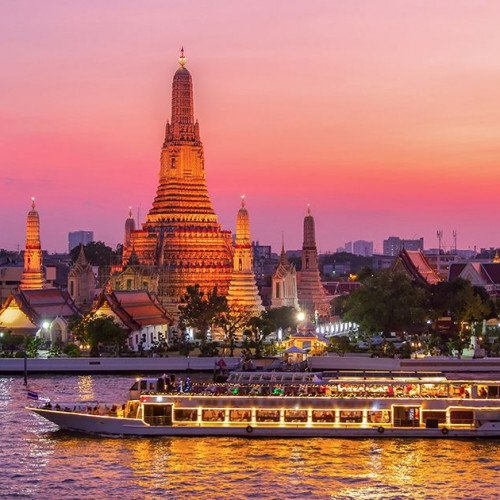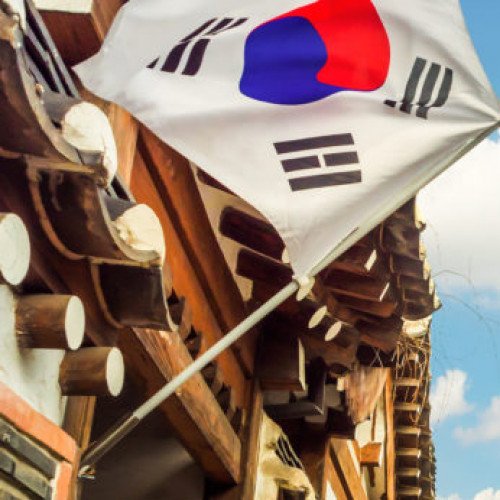Most vibrant country to visit in Asia: Korea vs Thailand

Thailand
Thailand, officially the Kingdom of Thailand and formerly known as Siam, is a country in Southeast Asia. Located at the centre of the Indochinese Peninsula, it is composed of 76 provinces spanning 513,120 square kilometres (198,120 sq mi), with a population of over 66 million people; Thailand is the world's 50th-largest country by land area and the 22nd-most-populous. The capital and largest city is Bangkok, a special administrative area. Thailand is bordered to the north by Myanmar and Laos, to the east by Laos and Cambodia, to the south by the Gulf of Thailand and Malaysia, and to the west by the Andaman Sea and the southern extremity of Myanmar. Its maritime boundaries include Vietnam in the Gulf of Thailand to the southeast, and Indonesia and India on the Andaman Sea to the southwest. Nominally, Thailand is a constitutional monarchy and parliamentary democracy; however, in recent history, its government has experienced multiple coups and periods of military dictatorships. Tai peoples migrated from southwestern China to mainland Southeast Asia from the 11th century; the oldest known mention of their presence in the region by the exonym Siamese dates to the 12th century. Various Indianised kingdoms such as the Mon kingdoms, Khmer Empire and Malay states ruled the region, competing with Thai states such as the Kingdoms of Ngoenyang, Sukhothai, Lan Na and Ayutthaya, which rivalled each other. Documented European contact began in 1511 with a Portuguese diplomatic mission to Ayutthaya, which became a regional power by the end of the 15th century. Ayutthaya reached its peak during cosmopolitan Narai's reign (1656–1688), gradually declining thereafter until being ultimately destroyed in the 1767 Burmese–Siamese War. Taksin (r. 1767–1782) quickly reunified the fragmented territory and established the short-lived Thonburi Kingdom. He was succeeded in 1782 by Buddha Yodfa Chulaloke (r. 1782–1809), the first monarch of the current Chakri dynasty. Throughout the era of Western imperialism in Asia, Siam remained the only nation in the region to avoid being colonized by foreign powers, although the Siamese government was often forced to cede both territory and trade concessions in unequal treaties. The Siamese system of government was centralized and transformed into modern unitary absolute monarchy in the reign of Chulalongkorn (r. 1868–1910). Siam joined World War I siding with the allies, a political decision to amend the unequal treaties. Following a bloodless revolution in 1932, Siam became a constitutional monarchy and changed its official name to "Thailand". Thailand was a satellite of Japan in World War II. In the late 1950s, a military coup under Field Marshal Sarit Thanarat revived the monarchy's historically influential role in politics. Thailand became a major ally of the United States, and played a key anti-communist role in the region as a member of the Southeast Asia Treaty Organization (SEATO). Apart from a brief period of parliamentary democracy in the mid-1970s, Thailand has periodically alternated between democracy and military rule. Since the 2000s, Thailand has been caught in a bitter political conflict between supporters and opponents of Thaksin Shinawatra, which culminated in two coups, most recently in 2014 and the establishment of its current and 20th constitution and faces the ongoing 2020 Thai protests. Thailand is a founding member of the Association of Southeast Asian Nations (ASEAN). Despite comparatively sporadic changes in leadership, it is considered a middle power in global affairs. With a high level of human development, the second-largest economy in Southeast Asia, and the 20th-largest in the world by PPP, Thailand is classified as a newly industrialized economy; manufacturing, agriculture, and tourism are leading sectors of the economy.
Statistics for this Xoptio

Korea
Korea (or Korean Peninsula) is a region in East Asia. Since 1945 it has been divided into two sovereign states: North Korea (officially the "Democratic People's Republic of Korea") and South Korea (officially the "Republic of Korea"). Korea consists of the Korean Peninsula, Jeju Island, and several minor islands near the peninsula. It is bordered by China to the northwest and Russia to the northeast. It is separated from Japan to the east by the Korea Strait and the Sea of Japan (East Sea). During the first half of the 1st millennium, Korea was divided between the three competing states of Goguryeo, Baekje, and Silla, together known as the Three Kingdoms of Korea. In the second half of the 1st millennium, Silla defeated and conquered Baekje and Goguryeo, leading to the "Unified Silla" period. Meanwhile, Balhae formed in the north, superseding former Goguryeo. Unified Silla eventually collapsed into three separate states due to civil war, ushering in the Later Three Kingdoms. Toward the end of the 1st millennium, Goguryeo was resurrected as Goryeo, which defeated the two other states and unified the Korean Peninsula as a single sovereign state. Around the same time, Balhae collapsed and its last crown prince fled south to Goryeo. Goryeo (also spelled as Koryŏ), whose name developed into the modern exonym "Korea", was a highly cultured state that created the world's first metal movable type in 1234. However, multiple incursions by the Mongol Empire during the 13th century greatly weakened the nation, which eventually agreed to become a vassal state after decades of fighting. Following military resistance under King Gongmin that ended Mongol political influence in Goryeo, severe political strife followed, and Goryeo eventually fell to a coup led by General Yi Seong-gye, who established Joseon in 17 July 1392. The first 200 years of the Joseon era were marked by relative peace. During this period, the Korean alphabet was created by Sejong the Great in the 15th century and there was increasing influence of Confucianism. During the later part of the dynasty, Korea's isolationist policy earned it the Western nickname of the "Hermit Kingdom". By the late 19th century, the country became the object of imperial design by the Empire of Japan. After the First Sino-Japanese War, despite the Korean Empire's effort to modernize, the country was annexed by Japan in 1910 and ruled by it until the end of World War II in August 1945. In 1945, the Soviet Union and the United States agreed on the surrender of Japanese forces in Korea in the aftermath of World War II, leaving Korea partitioned along the 38th parallel. The North was under Soviet occupation and the South under U.S. occupation. These circumstances became the basis for the division of Korea by the two superpowers with two different ideologies, exacerbated by their inability to agree on the terms of Korean independence. The Communist-inspired government in the North received backing from the Soviet Union in opposition to the pro-Western government in the South, leading to Korea's division into two political entities in 1948: North Korea, and South Korea. Tensions between the two resulted in the outbreak of the Korean War in 1950. With involvement by foreign troops, the war ended in a stalemate in 1953, but without a formalized peace treaty. This status contributes to the high tensions that continue to divide the peninsula. Both governments of the two Koreas continue to claim to be the sole legitimate government of this region.